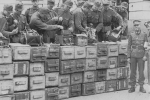
The destruction of Kyiv, then and now?
‘The fact that we took Kyiv without fundamentally destroying it ran counter to intentions. The plan was to lay the city so low that it could no longer become a hub of nationalist or Bolshevik resistance for a long time. The troops in the operational area failed to carry out this clear order, meaning we are forced to conceal in our reports that Kyiv has not actually been destroyed. Perhaps there will be another opportunity to achieve the desired goal.’
This was according to the Nazi propagandist Joseph Goebbels in September 1941, a few days after the capture of the city by the German army. A month beforehand, Field Marshal Wilhelm Keitel, the commander-in-chief of the Wehrmacht, who was hanged as a war criminal five years later, had indeed ordered the destruction of Kyiv.
Destruction at a distance
In the end Goebbels’ wish would partly come true, though not in the way he had envisaged. On 24 September 1941, two days after he made his complaint, the destruction of the city centre began – to the great shock of the Germans. Moscow had previously ordered a special Red Army engineering unit to hide numerous mines surreptitiously in and under buildings before the Germans arrived. Now, less than a week after the German entry that had left the city almost completely intact, the Russians used radio waves to detonate the mines at a safe distance, without any warning.
Within a week’s time, Kyiv’s main street, Chresjtsjatyk, and the surrounding streets had been reduced to ashes. The destruction of this area, around a square kilometre, naturally came at a human cost. Stalin’s precise intentions with this action are unclear, because we know of no surviving documentation. It seems that the goal was not military, strictly speaking – after all, the German advance could no longer be slowed – but to make the life and rule of the German occupying forces in Kyiv as unpleasant as possible.
It should be added that Stalin’s scorched-earth policy was not an unequivocal success. A rapid search enabled the Germans to remove hundreds of other mines in time, for example in the Kyiv Pechersk Lavra (an extremely important Orthodox site). Most of these other buildings remained intact for the time being.
Thus, in 1941 the regimes in both Berlin and Moscow showed no hesitation in deliberately destroying Kyiv, regardless of civilian casualties.
The alleged cradle of Russia
Many decades later, Putin is attempting to recapture Ukraine with a colonial war and erase Ukrainian identity. Like Stalin, the dictator he regards as an ‘efficient manager’, Putin considers the killing of civilians acceptable. Unlike Stalin, Putin does not even recognise Ukrainian identity.
For the nationalist Putin, however, Kyiv is the ‘cradle’ of Russia. According to Russian mythology, the origins of ancient Russia lie in Kyiv. Does this mean that he will show more mercy to Ukraine than to Syria, where, for example in Aleppo, he had Russian bombers flatten entire residential areas in order to achieve political goals? After all, Syria ‘only’ concerned Muslims, who have little to do with the ‘Russian world’, in Putin’s view.
The answer is no, as shown by the recent shelling. One foretaste was the attack on the television tower that was erected in Soviet times near the former ravine of Babyn Jar, the area where tens of thousands of Jews and others were murdered in 1941-1943.
Worldwide sympathy
The Ukrainian resistance is led by a Jewish Ukrainian, a president previously known in his own country for his comedy work in his native tongue, Russian. Long viewed with suspicion by more explicitly patriotic Ukrainians, Zelensky is now drawing support and sympathy from every corner. The notion that Ukraine needs to be ‘de-Nazified’ is patently absurd. It is partly due to the actions of the Ukrainian president that the resistance is so massive. Nothing is more symbolic of this than the issuing of weapons to civilians in the city, which the international media now increasingly calls Kyiv, the Ukrainian name for a city that used to be known by its Russian name (Kiev). Never before in history have Ukrainians experienced so much sympathy around the world.
None of these factors, unprecedented in Ukrainian history, will be sufficient to save the Ukrainian capital. Time and again, my thoughts go out to friends and colleagues who are still in Kyiv. Will they survive? Are they going to witness the destruction of their beloved city?
In September 1941, part of Kyiv city centre was destroyed; not by the German occupying forces, but by the Russian Red Army. The latter remotely detonated mines that were hidden before German troops arrived in the city. Stalin proved willing to sacrifice the city and its inhabitants to thwart the German enemy. NIOD researcher Karel Berkhoff, who specialises in the history of Eastern Europe and the Holocaust, fears that history will repeat itself in Kyiv.
